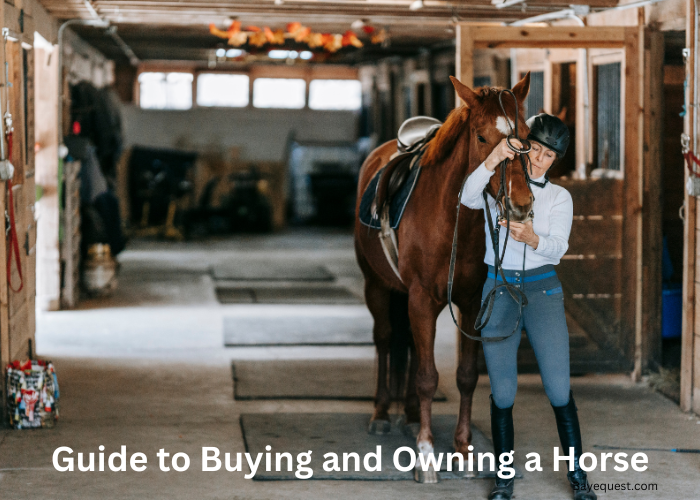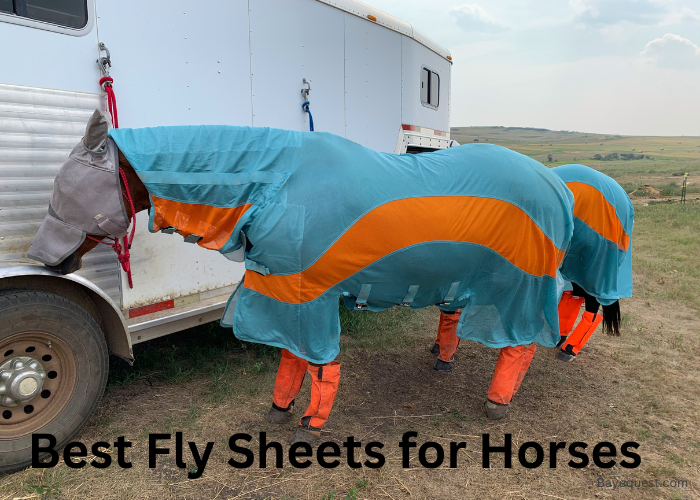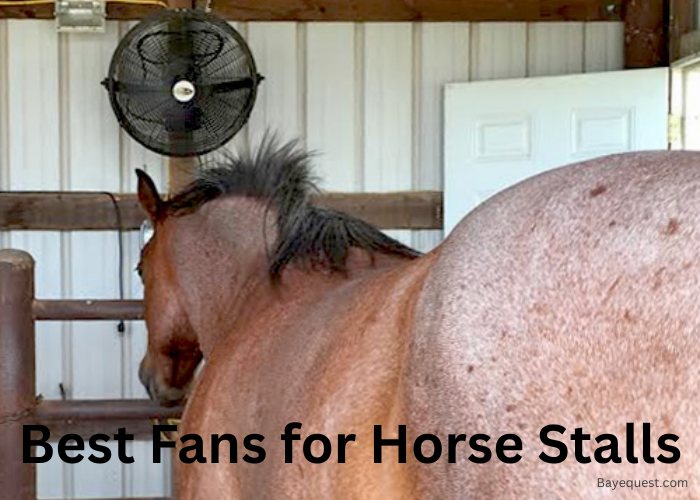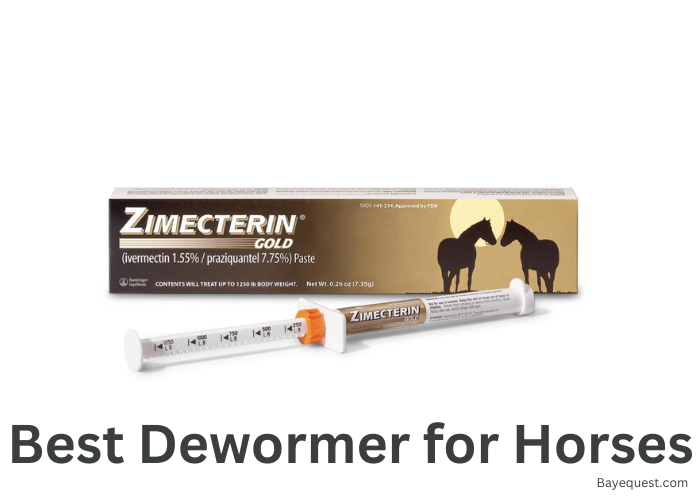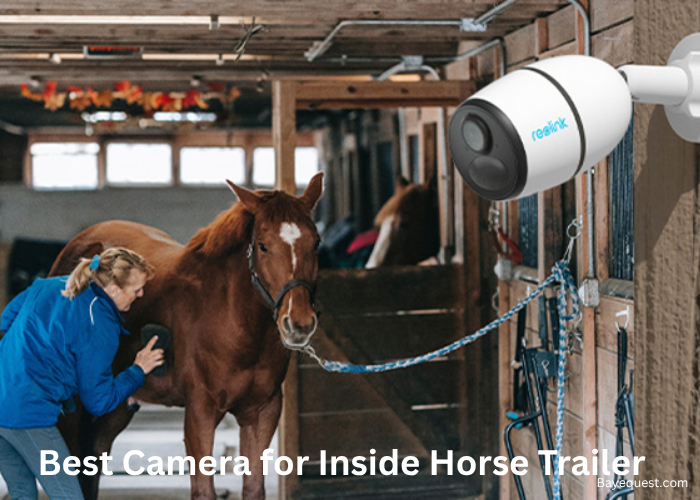Buying a horse is a big step. It’s exciting but also a huge responsibility. Whether you’re new to horses or getting back into riding, this guide will help you make smart choices.
From picking the right horse to daily care, we’ll walk you through it all. Horses need time, money, and attention, so you need to be prepared.
We’ll also cover common mistakes first-time owners make and how to avoid them. If you’re dreaming of owning a horse, this guide is a great place to start.
Let’s make your horse journey smooth and enjoyable.
Guide to Buying and Owning a Horse: Key Takeaway
- Set your goals
- Research on breeds and types
- Locate reputable sellers
- Evaluate the potential horses
- Create a safe environment
- Gather essential supplies
- Build a support network
- Understand horse dietary needs
- Learn about horse grooming routines
- Develop a horse training plan
- Learn health issues and preventive measures
- Equip yourself and your horse
- Build a relationship with your horse
What to Know Before Buying a Horse
Buying a horse is a major commitment. It’s not just about the initial excitement.
You need to assess your readiness. Do you have enough experience with horses? If not, are you willing to learn?
Horse care requires time. Daily attention is a must. This isn’t a pet you can leave unattended.
Are you prepared for that level of commitment?
Financially, owning a horse can be expensive. There are upfront costs and ongoing expenses. This includes feed, vet care, and equipment.
Unexpected medical issues can arise too. Be sure you’re financially prepared for these costs. Physical capability is also important.
Horse care can be physically demanding. Ensure you’re up for the challenge.
Defining your goals is crucial. Why do you want a horse? Is it for riding, competition, or companionship? Your purpose will guide your decisions.
Different breeds suit different needs. Research breeds that match your goals and experience level.
Finding the right horse involves research. Look for reputable breeders or rescue organizations. Avoid scams and unethical sellers.
When evaluating a horse, a pre-purchase exam is essential. Check for health, temperament, and training. A vet check is a must before finalizing any purchase.
Preparing for the horse’s arrival is a big task. Ensure you have a safe environment. This includes stables, pastures, and secure fencing.
Gather essential supplies. This includes tack, grooming tools, feeding supplies, and a first aid kit. Building a support network is key.
Find a good vet, farrier, and trainer. Joining local horse communities can provide valuable support and advice.
Daily care and management are vital. Horses need a proper diet. Develop a consistent feeding schedule.
Grooming and health maintenance are daily tasks. Regular check-ups are crucial. Dental and hoof care are part of this routine.
Exercise and training are important too. Regular exercise keeps your horse healthy. Consistent training helps with behavior and bonding.
You also have to understand common health issues. Learn to recognize signs of illness. Preventive care practices can help avoid major problems.
Regular vet visits, vaccinations, and parasite control are essential. Dental care is also important.
Financial considerations should not be overlooked. Budget for both initial and ongoing expenses.
Consider the cost of the horse, vet checks, and transportation.
Horse monthly costs for feed and bedding can add up. Insurance and understanding your legal liabilities as a horse owner are also important.
Finally, be sure you’re prepared for the commitment. Your horse will rely on you for care and attention. Make sure you’re ready for the responsibility.
Tips to Navigate the Process of Buying a Horse
With so many choices and things to consider, buying a horse can feel overwhelming. This section breaks it down with smart, practical tips to help you find the right horse and avoid costly mistakes.
Let’s make the journey smoother, one step at a time.
1. Assess your readiness
You need to assess your readiness. Start by evaluating your experience with horses.
Have you spent enough time around them? If not, consider taking some riding lessons or volunteering at a stable. This will give you a good foundation.
Next, think about your time commitment. Horses need daily care.
Are you ready to spend several hours a day on feeding, grooming, and exercising? If you have a busy schedule, this might be a challenge.
Financial readiness is also key. Owning a horse is expensive. You’ll have costs for feed, vet care, equipment, and boarding if you don’t have your land. Make sure you have a stable income to cover these expenses.
Physical capability is another factor. Horse care is physically demanding. You need to be able to handle the physical tasks involved, like mucking out stalls and lifting heavy feed bags.
To ensure success, create a checklist of these readiness factors. Evaluate each one honestly. If you find gaps, take steps to fill them.
This could mean gaining more experience, adjusting your schedule, or improving your financial situation.
Failure to assess your readiness properly can lead to problems down the line. You might find yourself overwhelmed by the demands of horse ownership.
So, take this step seriously and prepare thoroughly.
2. Set your goals
Setting your goals is essential when buying a horse. Start by asking yourself why you want a horse.
Is it for riding, competition, or companionship? Your purpose will guide your decisions.
Next, think about what you want to do with your horse. Do you plan to participate in shows or enjoy leisurely trail rides?
Each activity may require different breeds and training levels.
Research is key here. Look into different horse breeds. Each breed has unique characteristics and strengths.
Find one that matches your goals. For example, some breeds excel in equestrian sports, while others are perfect for casual riding.
Make a list of your priorities. What is most important to you? Is it the horse’s temperament, training level, or age? Having clear priorities will help you stay focused.
To ensure you’re on the right track, talk to experienced horse owners or trainers. They can offer valuable insights and advice based on their experiences.
Failure to set clear goals can lead to buying a horse that doesn’t fit your needs. You might end up with a horse that requires more training than you can handle or one that doesn’t suit your activities.
Setting your goals helps you find the perfect match and ensures a rewarding experience.
3. Research on breeds and types
Each horse breed has its characteristics, thus important to choose the right one for your needs.
Start by identifying breeds known for excelling in your areas of interest. For example, Thoroughbreds are great for racing, while Quarter Horses excel in ranch work and Western riding.
Visit breed association websites and read up on the history and traits of various breeds. Look at their temperament, physical attributes, and common health issues.
This information will help you understand what to expect.
Attend horse shows and events to see different breeds in action. Talk to breeders and owners.
Ask about their experiences and the pros and cons of their chosen breeds. Seeing the horses in person gives you a better sense of their size, behavior, and suitability for your goals.
Consider the horse’s age and training level as well.
Younger horses may require more training and patience. Older horses might be more settled but could have health issues.
Make a list of breeds that align with your goals. Note their key traits and requirements. Compare this list with your needs and abilities.
Failure to research breeds can lead to mismatched expectations. You might end up with a horse that’s unsuitable for your activities or too difficult to manage.
Thorough research ensures you choose a breed that fits well with your lifestyle and goals.
4. Locate reputable sellers
Before getting yourself a horse, you need to find a reputable seller for a healthy and well-trained horse.
Start by asking for recommendations from trusted sources. Speak to your trainer, vet, or friends who own horses. They can point you towards reliable breeders and sellers.
Check online resources. Look for breeder associations and equine marketplaces. Read reviews and testimonials. This can give you insights into the seller’s reputation and the quality of their horses.
Visit the seller’s facility if possible. Observe the living conditions of the horses. A clean, well-maintained environment is a good sign.
Ask to see the horses’ health records. A reputable seller will be transparent about the horse’s medical history and care.
Ask about the seller’s experience and background. How long have they been in the business? Do they have any affiliations with recognized equine organizations?
Sellers with a solid track record and professional affiliations are generally more trustworthy.
Conduct a background check. Search for any complaints or legal issues associated with the seller. Websites like Better Business Bureau can be helpful for this.
To ensure success, always get a pre-purchase exam from an independent vet.
This can uncover any hidden health issues. A reputable seller will have no problem with this request.
Failure to find a reputable seller can result in buying a horse with hidden health or behavioral issues. This can lead to significant costs and frustration.
Thoroughly vetting your seller ensures you get a healthy, well-cared-for horse, making your horse ownership experience much more rewarding.
5. Evaluate the potential horses (Pre-purchase considerations)
Evaluating potential horses involves several pre-purchase considerations.
First, observe the horse’s overall health. Look for clear eyes, a shiny coat, and good muscle tone.
Check for signs of illness or injury. Ask for veterinary records to verify the horse’s health history.
Temperament is crucial. Spend time with the horse to see how it interacts with people and other animals.
Training and behavior are key factors. Ask about the horse’s training history. Is it well-trained for your intended activities?
Test the horse under the saddle and on the ground. Watch how it responds to commands and different situations. A well-trained horse should be responsive and manageable.
Age and experience matter. Younger horses might be more energetic and require more training.
Older horses can be calmer and more experienced but might have health issues.
Choose an age that suits your needs and abilities. Middle-aged horses often strike a good balance.
Consider the horse’s conformation, which is its body structure. Good conformation indicates a healthy and sound horse.
Request a pre-purchase vet exam. This thorough examination can uncover hidden health issues.
The vet will check the horse’s overall health, soundness, and suitability for your intended use.
To ensure you don’t miss anything, create a checklist of these evaluation points. Take notes during your assessment and compare different horses based on these criteria.
Failure to evaluate potential horses properly can lead to problems later. You might end up with a horse that has health issues or isn’t suitable for your experience level.
Taking the time to evaluate thoroughly ensures a successful and rewarding purchase.
6. Create a safe environment
To create a safe environment for your horse, start with secure housing. Ensure your stables are sturdy and well-ventilated.
Proper ventilation helps prevent respiratory issues. Make sure the stall doors and gates are secure to prevent escapes.
Check your fencing. It should be strong and well-maintained. Avoid barbed wire as it can cause injuries. Electric fencing can be useful but ensure it’s properly installed and maintained.
Provide adequate shelter. Horses need protection from extreme weather.
A well-built barn or run-in shed offers shade in summer and warmth in winter. Ensure the shelter is dry and free from drafts.
The pasture is also crucial. Ensure it’s free from toxic plants and hazardous objects. Regularly walk the pasture to check for holes, sharp objects, or any other potential dangers.
Keep the grazing area clean and well-managed.
Access to clean water is vital. Horses need constant access to fresh, clean water. Check water troughs daily and clean them regularly to prevent contamination.
Feed storage is another consideration. Store feed in a dry, secure area to prevent mold and pests. Use sturdy containers with tight lids to keep feed fresh and safe from rodents.
First aid supplies are a must. Have a well-stocked first aid kit easily accessible.
Include bandages, antiseptics, and other basic medical supplies. Know the basics of horse first aid and have your vet’s contact information handy.
To ensure you’ve covered everything, create a safety checklist. Regularly review and update it. Walk through your property with a critical eye, looking for potential hazards.
Failure to create a safe environment can lead to injuries and health issues for your horse. Ensuring a secure and comfortable living space helps keep your horse healthy and happy.
7. Gather essential supplies
Gathering essential supplies is also crucial when preparing for your horse’s arrival. Start with the basics: tack and grooming tools.
You’ll need a well-fitting saddle, bridle, and reins. Make sure these items are comfortable for both you and your horse. Include saddle pads and girths, and ensure they are of high quality.
Grooming tools are essential for daily care. Purchase brushes, hoof picks, combs, and sponges.
These tools help keep your horse clean and healthy. A grooming kit should also include a mane and tail detangler and fly spray to protect your horse from insects.
Feeding supplies are next. Invest in good-quality feed bins and hay racks. Make sure you have a supply of hay, grain, and any necessary supplements.
Consult with your vet to develop a balanced diet for your horse. Don’t forget water buckets or automatic waterers to ensure your horse always has access to fresh water.
First aid supplies are a must. Have a well-stocked first aid kit that includes bandages, antiseptics and wound dressings. Learn basic first aid procedures and keep your vet’s contact information handy for emergencies.
Stable supplies are also important. This includes bedding materials such as straw, shavings, or pellets.
Choose bedding that is absorbent and comfortable. Cleaning tools like pitchforks, wheelbarrows, and stable brooms are necessary to maintain a clean environment.
Training equipment is useful for ongoing education and exercise. Lunge lines, training whips, and ground poles can help with various training routines.
Lastly, safety gear for yourself is important. Invest in a good-quality helmet, riding boots, and gloves. These items protect you while riding and handling your horse.
To ensure you’ve gathered everything, make a checklist of these essential supplies. Regularly update and check it before your horse arrives.
Having the right supplies on hand ensures you’re prepared for daily care and any emergencies.
Failure to gather essential supplies can lead to difficulties in properly caring for your horse. Being well-prepared helps provide a comfortable and safe environment for your new equine friend.
Read also: How to Design a Tack Room.
8. Build a support network
How do I build a support network? You may wonder. It’s easy.
Start by finding a reliable vet. Look for someone experienced with horses. Ask for recommendations from other horse owners.
Regular check-ups and vaccinations are vital for your horse’s health. Having a vet you trust ensures you have expert care when needed.
Next, find a skilled farrier. Regular hoof care is crucial. A good farrier will keep your horse’s hooves in excellent condition.
Ask around for recommendations and check their credentials. Schedule regular visits to avoid hoof problems.
Consider hiring a trainer if you’re not experienced. A trainer can help with riding lessons and horse behavior. They can also assist with any training issues you might encounter.
Join local horse communities and clubs. These groups can offer support, advice, and camaraderie. They often have events and activities where you can meet other horse owners.
Consider boarding options if you don’t have your facilities. Research local stables and visit them in person.
Ensure they have good living conditions and reliable staff. Boarding can provide additional support and resources.
To ensure you have a strong network, make a list of these key contacts: vet, farrier, trainer, feed supplier, and boarding facilities. Keep their contact information handy.
9. Understand horse dietary needs
Horse’s dietary needs are crucial just like human’s.
Start with the basics: forage. Horses need a diet rich in fiber, which comes from hay or pasture grass.
Ensure your horse has access to high-quality hay or good grazing. Forage should make up the majority of their diet.
Next, consider concentrate feeds. These include grains and commercial feeds.
Concentrates provide additional nutrients and energy. However, you need to feed them in moderation. Too much can lead to health issues like colic or laminitis.
Consult with your vet to determine the right amount based on your horse’s age, weight, and activity level.
Water is essential. Horses need access to fresh, clean water at all times. An average horse drinks between 5-10 gallons of water a day. Check and refill water sources regularly to ensure they never run dry.
Minerals and vitamins are also important. Provide a salt lick or mineral block in your horse’s feeding area. These supplements help ensure they get essential nutrients that might be lacking in their regular diet.
Pay attention to your horse’s body condition. Regularly check their weight and adjust their diet as needed.
If your horse is gaining or losing too much weight, consult your vet or a nutritionist for advice. They can help you create a balanced diet plan.
Feeding schedules matter. Horses have small stomachs and are natural grazers. They do best with several small meals throughout the day rather than one or two large ones.
Observe your horse for any signs of dietary problems. Changes in weight, coat condition, or behavior can indicate nutritional deficiencies or excesses.
Regularly consult with your vet to ensure your horse’s diet remains balanced and healthy.
10. Learn about horse grooming routines
To maintain your horse’s health and appearance, you will need to learn how to groom it.
Regularly brush it to remove dirt, debris, and loose hair. Use a curry comb to loosen dirt and stimulate the skin.
Follow with a stiff brush to remove the loosened dirt and finish with a soft brush for a smooth coat.
Pay attention to your horse’s mane and tail. Use a mane comb or brush to detangle and clean them. Be gentle to avoid pulling out hair.
Hoof care is also crucial. Pick out your horse’s hooves daily to remove dirt, stones, and debris. This helps prevent infections and other hoof problems.
Check for signs of thrush or cracks. Regular hoof care ensures your horse stays comfortable and sound.
Bathing is part of grooming but should be done as needed. Use horse-specific shampoo to clean your horse. Also, avoid over-bathing, as it can strip natural oils from the coat.
Inspect your horse’s skin during grooming. Look for cuts, bumps, or signs of skin conditions. Early detection will help you with prompt treatment.
Check your horse’s eyes, ears, and nose regularly. Clean any discharge gently with a damp cloth.
Healthy eyes should be clear and bright. Ears should be clean and free of odor, and the nose should have no significant discharge.
Grooming is also an opportunity to bond with your horse. Spend time talking and interacting with them during grooming sessions. This builds trust and strengthens your relationship.
To ensure you’re following a good horse grooming routine, create a checklist. Include daily tasks like brushing and hoof picking, and weekly or monthly tasks like bathing and trimming the mane and tail.
11. Develop a horse training plan
To have a well-behaved horse, you will need to develop a horse training routine.
Start by setting clear goals for what you want to achieve. Assess your horse’s current training level to know where to begin.
Create a regular training schedule with short, consistent sessions. Begin with basic ground manners like leading and halting.
Gradually introduce foundational riding skills. Use positive reinforcement to encourage good behavior. Address any behavioral issues calmly and promptly.
Introduce new challenges slowly to build confidence. You will also need to keep a training journal to monitor progress.
Be patient and flexible, adjusting the plan as needed. If needed, seek help from a professional trainer. Safety should always be a priority for both you and your horse.
12. Learn the common health issues and preventive measures
Learning about common health issues and their preventive measures is crucial for keeping your horse healthy.
Start with colic, a severe stomach pain. Watch for signs like rolling, sweating, and loss of appetite.
You can prevent colic by feeding your horse consistently, providing clean water, and ensuring regular exercise.
Laminitis affects the hooves and can cause lameness and heat in the feet. Prevent it by managing your horse’s diet and avoiding too much grain or lush pasture.
Respiratory issues, such as heaves, cause coughing and breathing difficulties. Ensure good ventilation in stables and reduce dust to help prevent these problems.
Parasites are another common issue. Regular deworming and fecal tests are essential to keep them under control. Rotating pastures and maintaining a clean environment also help.
Vaccinations are a must to prevent diseases. Follow your vet’s schedule for regular shots.
Don’t forget dental care. Check your horse’s teeth for sharp edges and schedule regular dental check-ups to avoid problems.
A healthy diet and regular exercise are key to overall well-being. Proper nutrition supports health, while exercise keeps your horse fit and reduces many health risks.
Monitor your horse’s weight and condition. Watch for changes in behavior, appetite, or appearance, and consult your vet if anything seems off.
Having a first aid kit and knowing basic first aid techniques can be lifesaving in emergencies. Learn how to handle common injuries and health issues.
By staying informed and proactive, you can help ensure your horse stays healthy and happy. Regular check-ups and preventive care are essential for a long, healthy life for your horse.
13. Financial Considerations
We cannot talk about buying horses without mentioning finances. Here’s what you need to know about the costs involved:
Initial purchase costs
The first expense is the cost of the horse itself. Prices can vary widely depending on the breed, age, and training level.
A well-trained horse might cost between $3,000 to $50,000. However, prices can go much higher for top-quality horses.
Ongoing expenses
Once you have the horse, there are many ongoing costs to consider:
Feed and bedding. Expect to spend around $100 to $300 per month on feed and bedding.
Veterinary care. Routine vet visits, vaccinations, and deworming can cost about $300 to $600 annually. Unexpected medical issues can add significantly to this amount.
Farrier services. Hoof care is essential. Regular trimming and shoeing typically cost $50 to $150 every 6-8 weeks.
Boarding. If you don’t have your own facilities, boarding can be a major expense. Costs range from $300 to $800 per month, depending on the services provided.
Training and lessons. If you need ongoing training or riding lessons, budget for $30 to $100 per session.
Insurance and legal aspects
Insurance for horses can cover mortality, major medical, and liability. Mortality insurance usually costs about 3-5% of the horse’s value annually.
Major medical insurance ranges from $300 to $1,000 per year, depending on coverage limits. Liability insurance is crucial if your horse interacts with the public. It costs around $150 to $500 per year.
For legal aspects, consider the costs of contracts and liability waivers if you’re boarding or leasing horses. Legal fees for drafting these documents can range from $100 to $500.
14. Equipping yourself and your horse
Equipping yourself and your horse is an important step in horse ownership. One key aspect is getting a horse passport.
A horse passport is essential for travel, competitions, and medical records. It ensures your horse meets regulatory requirements. The cost for a horse passport is around $50 to $150.
Microchipping your horse is another critical measure. A microchip provides a permanent identification method.
It helps in case your horse gets lost or stolen. The microchip is implanted under the skin, usually in the neck. The cost for microchipping is generally between $45 to $80.
Both the passport and microchip are vital for proving ownership and ensuring your horse’s safety and well-being.
Investing in these measures helps protect your horse and comply with regulations.
15. Building a relationship with your horse
Building a relationship with your horse is like forming a deep friendship. Start with grooming—your horse’s version of spa time. It helps them get used to your touch and strengthens your bond.
Communicate with your horse. This goes beyond words. Learn to read your horse’s body language and respond with calm, clear signals.
When your horse does something right, celebrate it with treats, praise, or a gentle pat. It reinforces good behavior and makes your horse happy to see you.
Building a strong relationship takes time, however, skip the harsh punishments and try to see things from your horse’s perspective. A gentle, understanding approach works wonders.
Listen to your horse’s quirks. Every horse has its unique personality. Paying attention to their likes and dislikes helps deepen your connection.
Don’t forget to have fun! Sometimes, just hanging out without any training goals can be the best bonding experience. Let your horse graze while you relax nearby or take a leisurely walk together.
By investing in these simple yet meaningful activities, you’ll develop a strong, trusting, and rewarding relationship with your horse.
16. End-of-life considerations
End-of-life considerations are an important, though difficult, part of horse ownership. Planning ensures your horse’s final days are handled with dignity and compassion.
First, understand the signs of aging and declining health. Horses may show decreased mobility, weight loss, or chronic pain.
Discuss options with your vet early. They can provide valuable insights into your horse’s quality of life and when it might be time to consider euthanasia.
This decision is never easy, but it’s essential to prioritize your horse’s well-being and avoid unnecessary suffering.
Prepare for the financial aspects. End-of-life care, including euthanasia and disposal, can be costly. Euthanasia costs between $150 and $300, and disposal or burial can range from $200 to $1,000.
Consider the emotional impact. Losing a horse is like losing a family member. Seek support from friends, family, or equine support groups.
Plan for the practicalities. Decide whether you want a private burial, cremation, or another method of disposal.
Research local laws and services to understand your options. Having a plan in place can make this difficult time a bit more manageable.
Celebrate your horse’s life. Create a memorial, such as a plaque or a photo album, to honor your horse’s memory. Sharing stories and remembering the good times can be comforting.
End-of-life decisions are tough but necessary. By planning, you can navigate this challenging time with care and compassion.
Questions to Ask Before Buying a Horse
When buying a horse, asking the right questions is crucial to finding a healthy, well-suited companion. Here are a few questions to ask when buying a horse:
- What is the horse’s age and breed?
- Does the horse have any medical issues or past injuries?
- What level of training has the horse received?
- What is the horse’s temperament like?
- How does the horse behave around other horses and people?
- Has the horse ever competed or participated in any events?
- What is the horse’s current feeding regimen?
- How much daily exercise does the horse need?
- Why are you selling the horse?
- Can I see the horse’s veterinary and registration records?
Read also: Horse Abuse Facts and Cases.
Guide to Buying and Owning a Horse: Conclusion
Buying and owning a horse is an adventure like no other. It’s filled with joy, challenges, and endless rewards.
Remember, the right horse can gallop its way into your heart and life. Do your homework, ask the right questions, and build a strong bond.
Whether you’re trotting through fields or competing in shows, your journey together will be unforgettable. So saddle up, embrace the journey, and enjoy every hoofbeat.
Happy horse hunting and even happier horse owning.




